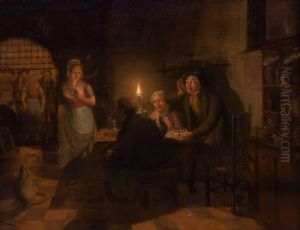Thomas Van Leent Paintings
Thomas van Leent was a Dutch painter born on February 10, 1826, in The Hague, Netherlands. He belonged to the 19th-century European art world and was primarily known for his genre paintings depicting scenes of everyday life, often with a humorous touch. Despite the fact that he is not widely recognized today, during his lifetime, van Leent enjoyed a certain degree of success and was part of the art scene that included a focus on realism and detail, which was popular during that time.
Van Leent trained at the Royal Academy of Art in The Hague, where he honed his skills and developed a keen eye for detail and composition. He was influenced by the Dutch Golden Age painters, as well as by his contemporaries who focused on genre scenes and the realistic portrayal of ordinary life.
Throughout his career, Thomas van Leent exhibited his works at various art shows and was known to have connections with art collectors and patrons. He painted a variety of subjects, including domestic interiors, tavern scenes, and more bucolic settings such as farms and rural life. His works are characterized by their vibrant color palette and the lively expressions of the figures he portrayed.
Despite his talent and the quality of his work, van Leent did not achieve the same level of fame as some of his contemporaries. As a result, his paintings are not as well known or as widely studied as those of other artists from the same period. Nevertheless, his contributions to Dutch art during the 19th century are still appreciated by those who study this era.
Thomas van Leent passed away on July 24, 1894, in his hometown of The Hague. While his name may not be immediately recognized in the annals of art history, his paintings continue to be of interest to collectors and historians who have a passion for 19th-century Dutch genre painting.




